Looking out from the Bridge this morning, it was snowing heavily, and about 4” had fallen overnight. It was not very windy, so it stayed on the decks. I could see about 100 meters off the bow, a large round-topped growler disappearing in the roll and then coming up and looming large. You can see why the person at the helm has to remain alert at all times this growler could do some damage if hit. (And no, we haven’t hit any.) The sea is changeable, and in 10 minutes we could go from clear open rolling ocean to chop, then to full ice floe with chunks to weave around.
Fur Seals Conflagration
Excitement in the water today!! We were making our way through the narrow Lemaire Channel, which should have been exciting enough in its topographical beauty, sheer cliffs of Antarctic rock covered with ice and snow… only we were in a blizzard and couldn’t see much, much less take adequate photos of it. But then, in a clearing in the floe ice ahead, the water was churning, seething, boiling with seals!!! A couple of hundred seals in this one pool of open water!! We steamed up and past them and ahead was another boiling clearing, and another and another!! We saw hundreds upon hundreds of seals, frolicking, fishing, whatever they were doing, they didn’t seemed bothered by the big orange ship!! We were out there in the snow, clicking, zooming, videoing away at this amazing site. We think they were fur seals, although we saw crabeater seals in small groups on top of the small icebergs in the channel. These in the water seemed happy to stay in the water none scooted up onto the bergs to escape the Gould or our gawking faces and pointing digits.
Getting to Know You
The Ship’s Bridge Crew
The ship’s Bridge is, aside from the engine room, the activity hub of the ship. It is from here that the ship’s course is plotted and from where the ship is steered. Taking the full area at the top of the ship’s 3 levels, it has a bright, broad Control Room at the highest (humanly habitable) point of the ship, where all of the navigational planning and execution of that plan takes place. It is surrounded by large windows for broad visibility (and so is the best place to go to see the sights from indoors!!), has a large instrument panel at it’s forward border, a charting table finishing off that end, and a large aft area for further charting and communications the Captain’s ‘office’, you might say. There is a good maritime information library, extensive charts files, and binder after binder of policies, procedures and instruction manuals.
Staffing for the Bridge crew begins with the ship’s captain who is basically on duty and/or on call 24 hours a day, plus three Mates - licensed helmsmen, who perform their duties in rotating shifts. There is every conceivable instrument, some in duplicate, for measuring and reporting back to a myriad of screens, the exact global positioning, speed, radar (picks up icebergs and land as well as other ships off in the distance), sonar, wind to name a few only some of which I use to update my Journal Header each day. At any given segment of our trip, there are not fewer than 3 charts at a time being used in the forward Bridge area. The mates and Captain are in those charts measuring, checking, double checking and drawing the lines that “plot” the course. They have filled page upon page of positioning and activity updates. There is regular radio contact with the ship’s technicians regarding the ship’s as well as science groups’ activities. We know it is very generous of them to let us be ‘in their space’ while they carry on with their appointed tasks, and so try to stay out of their way.
Captain Marty Galster
Marty’s seagoing career began at the tender age of 8 when a great uncle nearly drowned while fishing. The good man’s wife insisted that he gift his rowboat to his nephew whether she was motivated by concern for her husband, veiled dislike for her nephew, or both, remains an occasional topic of family debate. Since that time, he has worked aboard a dilapidated, 50-year-old tramp freighter, ocean going tugs, hydrofoils and passenger vessels. He came to Edison Chouest Offshore (ECO) almost 10 years ago following a career spent mostly in Alaska. He first worked in the Gulf of Mexico offshore oil field, then branched out to various research vessels operating in the Antarctic and Pacific Oceans. Marty insists that the only personal accomplishment worth note is that the most remarkable woman on the planet has graciously consented to spending a significant percentage of the past 20 years with him.
[Ed. note] The Captain meets regularly (often) with the Chief Scientist to devise and revise the day’s plan. Any changes in the master plan happen at this level, and are communicated down through the line of command. The Captain is also supervisor of all of the ship’s personnel throughout the cruise.
1st Mate Vladimir Repin
Vladimir was raised in St. Petersburg, Russia and now lives in Virginia USA. Through service in the Russian Merchant Marines, he made his way through the ranks and ultimately served as an icebreaker captain there for several years. A turning point in his career occurred when he found his next ship’s captain assignment in the U.S. at ECO. Now, highly respected by the people with whom he works, Vladimir is an invaluable and knowledgeable resource aboard this company’s ships, especially in Antarctic waters navigating its legendary ice.
2nd Mate Joe Abshire
Joe grew up in Lake Charles, LA. His dad had been in the Navy, and following that went to work for Tidewater Marine. In 1990, Joe decided he would like to do work like his dad’s, and was hired by Tidewater as an OS (deckhand). He took the exam and obtained his Mate’s license at age 22, after 4 years of experience in the waters of the Gulf of Mexico, Mexico, and Alaska (Prince William Sound). Two years later at 24, he sat for his Captain’s License for ships up to 1600 tons (which would include this ship). He spent 2 years in the waters near Singapore for Tidewater, took a year off to attend college (trying to make a viable career plan out of his interests in psychology, sociology, theology and philosophy to say this man has an introspective side would be an understatement), then went to work for ECO. He was first a ‘relief captain’ and was assigned to ships in the Gulf of Mexico. His first captain’s job was for ECO out of Nigeria. Those ships brought supplies to oil fields, and were at great risk for being pirated, especially in the Nigerian waters. The chance to go to Punta Arenas and work on the L.M. Gould looked good after about 2 years in Africa, and it is there that he started as 3rd Mate, is now 2nd Mate, and is working towards his Chief Mate’s license.
3rd Mate Larry Brissette
I have now met the Son of a Son of a Son of a Sailor.
Ship captaining runs through the blood of this sailor. Larry’s great grandfather, grandfather, dad and uncle all worked as captains on ships for U.S. Steel in the Great Lakes. His grandfather, with an 8th grade education, started as mess helper and worked his way up to captain. His dad joined the Navy after high school, worked in shipping for National Gypsum Corp., then went to U.S. Steel, like his father before him. Larry is the epitome of the ‘walking in the footsteps’ man, as he worked for 18 years for National Gypsum (his last 5 as a captain). Part of his career there involved teaching Maritime Studies for 2.5 years during his Great Lakes time. Somewhere he got wind of an opening with ECO on ships going to Antarctica, and this appealed to him in a large way. He’s been on the Gould for just 6 months, but finds it interesting and lucrative. His wife Mary Ann keeps their home in California, and looks forward to Larry’s return after a couple of upcoming cruises. He enjoys teaching, and is currently working on a curriculum to give a course for the 100-ton license.
[Ed. note: Every day I am up in the Bridge 2 or 3 times to check location and travel plans, or else just to see what I can see. I always gain some bit of navigational or environmental or human knowledge, and for that I am truly grateful. It is a major factor in the enjoyment of this cruise.]
Back to the Science
Station 60: Tonight we celebrate the last benthic (bottom) trawl of the cruise. It’s a little extra trawl that Chief Scientist threw into the schedule, and we’re all looking forward to the last haul from our current location which has a very muddy bottom. The Blake (“look what the cat dragged in”) Trawl has the honor of making the last contribution to the benthic team’s collection. It pulled in a tremendous lot of diverse critters. The benthic team has a long night ahead, but a very productive one. They can be very proud of the work they’ve done, and the specimens they’ve put away for a great raft of papers yet to be written!
Tomorrow, another stop for R&R, Palmer Station.
Don't hesitate to email
questions to us at outreach@lmg.usap.gov
|
|
Longitude/Latitude:
S65° 12.011’ W64° 12.273’
Temperature:
Wind: SSE 13-15kn
and heavy snow, visibility ~.8mi
Air Temp: -3.3°C
Wind Chill: -19.9°C
Surface Water Temp: -1.104°C
Menu:
Roast turkey, baked ham, brussels sprouts, mixed vegs, rice, rolls, salad; Pork chops, beef and spaghetti, brussels sprout, cauliflower, rolls, salad, macaroons, cake, ice cream and cookies.
Photos:
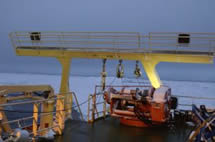
The clear wake’s path veering to the left shows a shift in our heading.
[Photo by Andy Mahon]
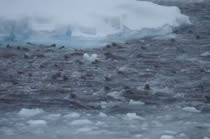
A boiling pot of seals in Lemaire Channel. [Photo by Andy Mahon]
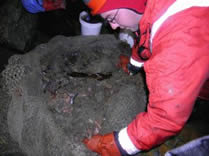
Andy Mahon digs in. [Photo by Ellen Bailey]
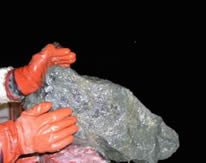
Ken Halanych happily pushes the last of the rocks back from whence it came.
[Photo by Ellen Bailey]
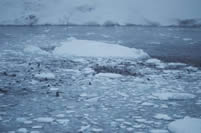
Huh??? [Photo by Andy Mahon]
Please excuse the indulgence most of us have never seen anything like this before.
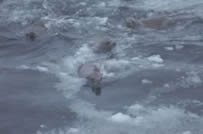
They were checking us out, too. [Photo by Andy Mahon]
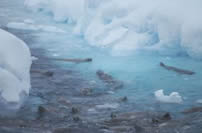
A day at the beach, for these guys. [Photo by Andy Mahon]
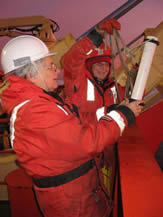
Izzie Williams and Pam Polloni measure water temperature
during a plankton tow. [Photo by Janis Umschlag]
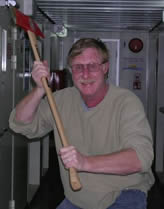
“Cabin fever??? What cabin fever??!?!?!?” Dr. Will Jaeckle just before he went to the“PhD Time Out” room. [Photo by Ellen Bailey]
|










